The glorious history of the GSX-R 750:

1985 GSX-R750F
The GSX-R750 was the World's first race-bred production four-stroke sportsbike. Featuring a 100bhp motor with an Endurance-style chassis and an aerodynamic full-fairing complete with Endurance-aping twin-headlights. Dry weight was a featherweight 179 kilos and the bike ran on 18-inch wheels. This bike sired the current generation of race-replica sportsbikes we see on the road today.

1986 GSX-R750G
Small changes to the GSX-R saw a 25mm longer swingarm and more powerful headlights. In this year a ,Double R' version for the US-market also made an appearance. This featured a dry-clutch, uprated suspension, amber Halogen headlights, a single-seat unit, fully-floating 310mm front brake discs and a steering damper. Many other features from the ,RR' ended up on the 750H.

1987 GSX-R750H
In 1987 the GSX-R became slightly more refined and the standard bike scored some of the previous models limited edition 'R' model goodies such as the stronger 41mm front forks and steering damper. The bike also now had the 310mm discs as standard fitment. Tyres and rims grew wider and a gold chain added to the bike's looks.

1988 GSX-R750J
A big change came in for the 1998 model year. Looks changed slightly to stay ahead of the times.
The light aluminium frame got stronger and the forks were now up to 43mm in diameter. Opposed
4-piston brake calipers aided things in the braking department. Engine cooling was improved by
way of bigger oil cooler and redline now started at 13,000rpm. Bore and Stroke also changed from the previous 70x48.7mm to 73x44.7mm. New 'SlingShot' carbs were fitted in the aim of improving the responsiveness of the new shorter stroke engine. Air ducts were added to the front of the fairing to try and improve induction efficiency.

1989 GSX-R750K and GSX-R750RK
Gear ratios were revised and another limited edition 'R' model was born. The GSX-R 750RK known as the double R was released in a limited run of 500 bikes. The engine reverted to the previous long stroke design and scored bigger 40mm carbs, close ratio gearbox and 4-into-1 exhaust. A fibreglass fairing, solo seat and 19-litre aluminium fuel tank helped achieve a 187 kilogram dry weight.

1990 GSX-R750L
Using the ,RR's long-stroke motor, the L also had new pistons, combustion chamber design and 38mm Slingshot carbs. Inverted or ,upside-down' front forks debuted on this model, as did the signature remote reservoir shock. A wider rear wheel rim also carried fatter tyres. Power was now up to 114bhp with weight around the 193 kilo mark.

1991 GSX-R750M
1991 saw the GSX-R become more streamlined in the aim of reducing aerodynamic drag. A bigger seat improved comfort and a twin light rear end added to the new look. The Valve gear system was changed to a one rocker arm per valve system and the use of shims for valve adjustment was claimed to reduce internal friction by 5%. A new intake and exhaust port design aimed to increase high rpm power.

1992 GSX-R750WN
The WN featured an all-new liquid-cooled motor for the first time in the GSX-R750 family. Liquid-cooling enabled Suzuki to get more power from the 750cc motor and keep that power consistent under all temperatures. The WN featured a new computer-designed frame and pressed aluminium swing-arm. Power was now up to 116bhp with dry weight at 208 kilos.

1993 GSX-R750WP
The second year of the water cooled engine saw the crankshaft moved lower in the crankcase to improve C-of-G and a reduced valve angle aimed to improve the level of intake charge. Thinner valve stems and 'Direct-Action' valve train aimed to improve high-rpm responsiveness. The compression ratio was upped to a very high 11.8:1 which improved throttle response. This along with an improved cool air intake served to increase the top speed.

1994 GSX-R750SPR
Although a standard production model, the GSX-R 750 SPR aimed to serve as Suzuki's SuperBike racing platform. Wide mouthed TRM40 carbs, special close ratio 6-speed gearbox, magnesium engine covers, thin walled 43mm USD forks, 6-piston calipers and a wide 180 section rear tyre put the GSX-R in front of all-comers once again. The weight of the GSX-R had bloated out a little with the arrival of water cooling in 1992 and the 1994 model aimed to redress this problem somewhat by reducing weight by 9 kilograms over the 1993 model.

1995 GSX-R750S
This was the final model to use the traditional GSX-R double cradle frame, which had been seen on GSX-Rs for a decade. Cosmetic changes included the looks of the SPR, including the ally water pump, six piston calipers, swingarm and magnesium engine parts. Other changes were a silver finish on the forks, instead of the previous model's blue.

1996 GSX-R750T
All-change. This model astonished journalists and GSX-R fans alike. With a beam-frame for the first time, an all-new motor pumping out 122bhp, it was known universally as the SRAD thanks to its Suzuki Ram Air Direct system which force-fed cold air into the airbox. The bike also shared the same dimensions as Kevin Schwantz's 1993 500cc GP winning RGV. It was a winner from the start. Weight was down back to 179 kilos - the same weight as the original bike but with almost 25% more power.

1997 GSX-R750V
This model was largely unchanged from 1996 with only aerodynamics and colour choices being changed.
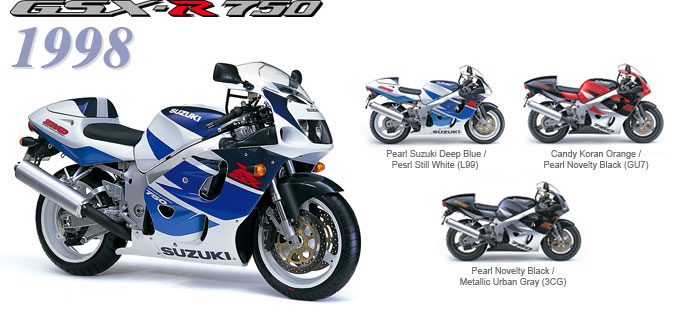
1998 GSX-R750W
With the '97 bike only receiving colour changes, the 1998 machine featured one very important addition: electronic fuel injection. The system used large 46mm throttle bodies and a two-stage system measuring water and intake temperatures, environmental and intake air pressures as well as throttle position and engine RPM to ensure optimal fuelling in all regimes.

1999 GSX-R750X
Only colours were changed in 1999.
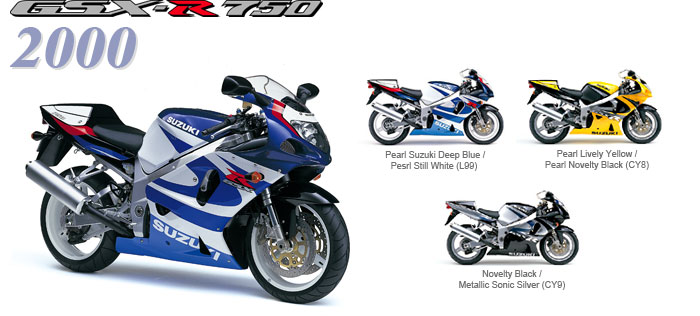
2000 GSX-R750Y
The Y was the lightest, most powerful GSX-R750 ever. With around 125bhp hauling just 166 kilos around, the bike was the leader of the 750 class, but was also able to take on the 600s and 1000cc sports machines.. A narrower valve angle, 12:1 compression and much smaller engine dimensions are the big changes but everything in the engine design is now at the forefront of technological development. The Fuel injection system gained two butterflies per cylinder that aimed to increase responsiveness from idle through to redline. The chassis had the same 1400mm wheelbase, but with a longer swingarm and lightened frame. A new look came from a complete aesthetic re-design.

2001 GSX-R750 K1
Colour changes only.
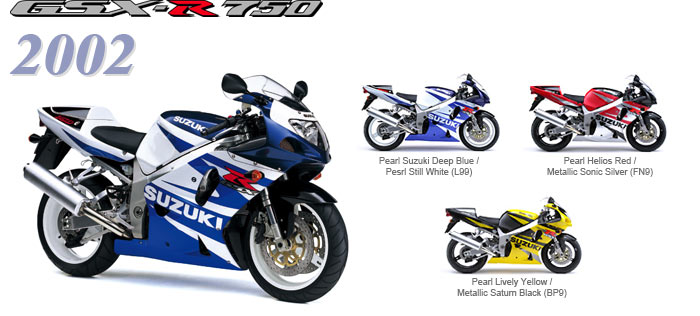
2002 GSX-R750 K2
For 2002 the GSX-R scored an adjustable swingarm which provides adjustment for height. The SDTV fuel injection system scored some improvements and an automatic cold start idle feature did away with the need for a fast-idle lever. Both headlights now remain illuminated, even when in low beam. New mirrors. The pipe leading to the muffler was changed to fully polished stainless steel.

2003 GSX-R750 K3
Colour changes only

2004 GSX-R750 K4
Sharing the chassis with the GSX-R600, the K4 750 has a new motor with lightweight pistons, increased compression ratio, new cams, titanium valves and a new cylinder head, adding up to a real-world 130bhp. Weight is down to 163 kilos thanks to a new frame, which is 15mm narrower than before. Four-pot Tokicos are awesome, while the narrow bodywork shares the overall look of the 2004 GSX-R600.

2005 GSX-R750 K5
Special 20th anniversary model introduced with special colours and graphics resembling that of the first 1985 model. The anniversary model features special logos and a serial number fitted to the top triple clamp while the ignition key features the GSX-R logo. A distinctive black muffler with 20th anniversary logo while the disc rotors are grooved. The machine also scores race style chassis protectors, a blue drive chain, gold anodised chain adjusters and a tinted screen.

A major styling update sees the 750K6 receive the looks of the GSX-R1000, but with motor changes to hike power to 150bhp. The motor now barks through a stubby, low-slung silencer. Weight is now down to 163 kilos thanks to a re-designed frame and chassis.

Color options: Blue/White, Blue/Black, Gray/Silver, Black
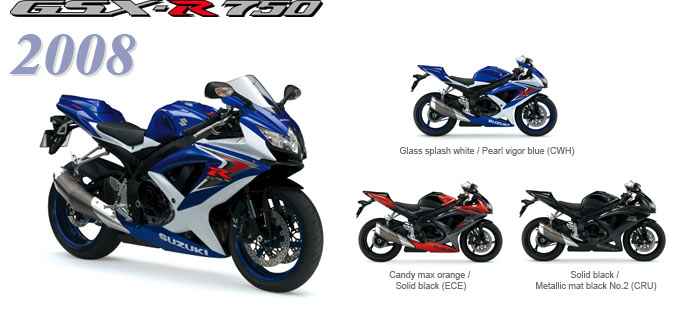
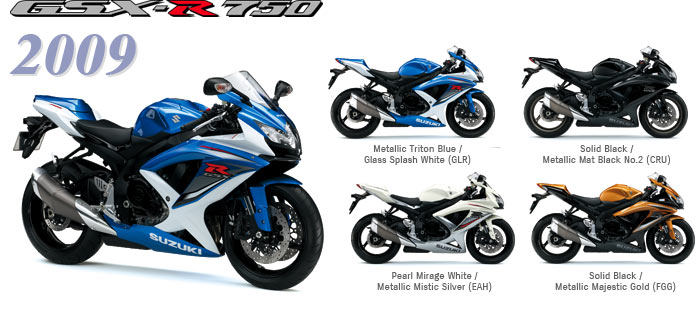
Sources: MCNEWS.COM.AU, Suzuki GB, www.suzukicycles.org